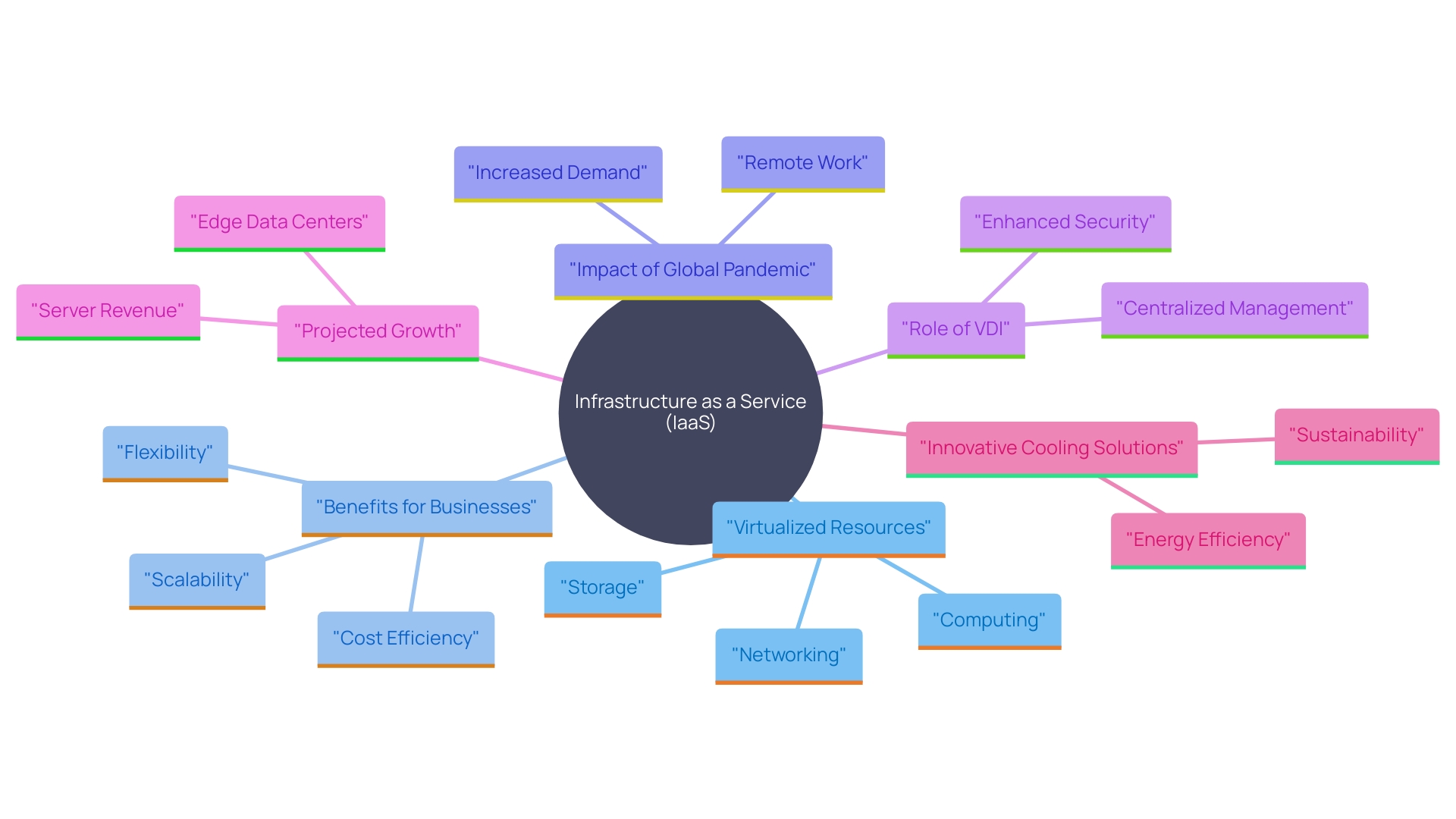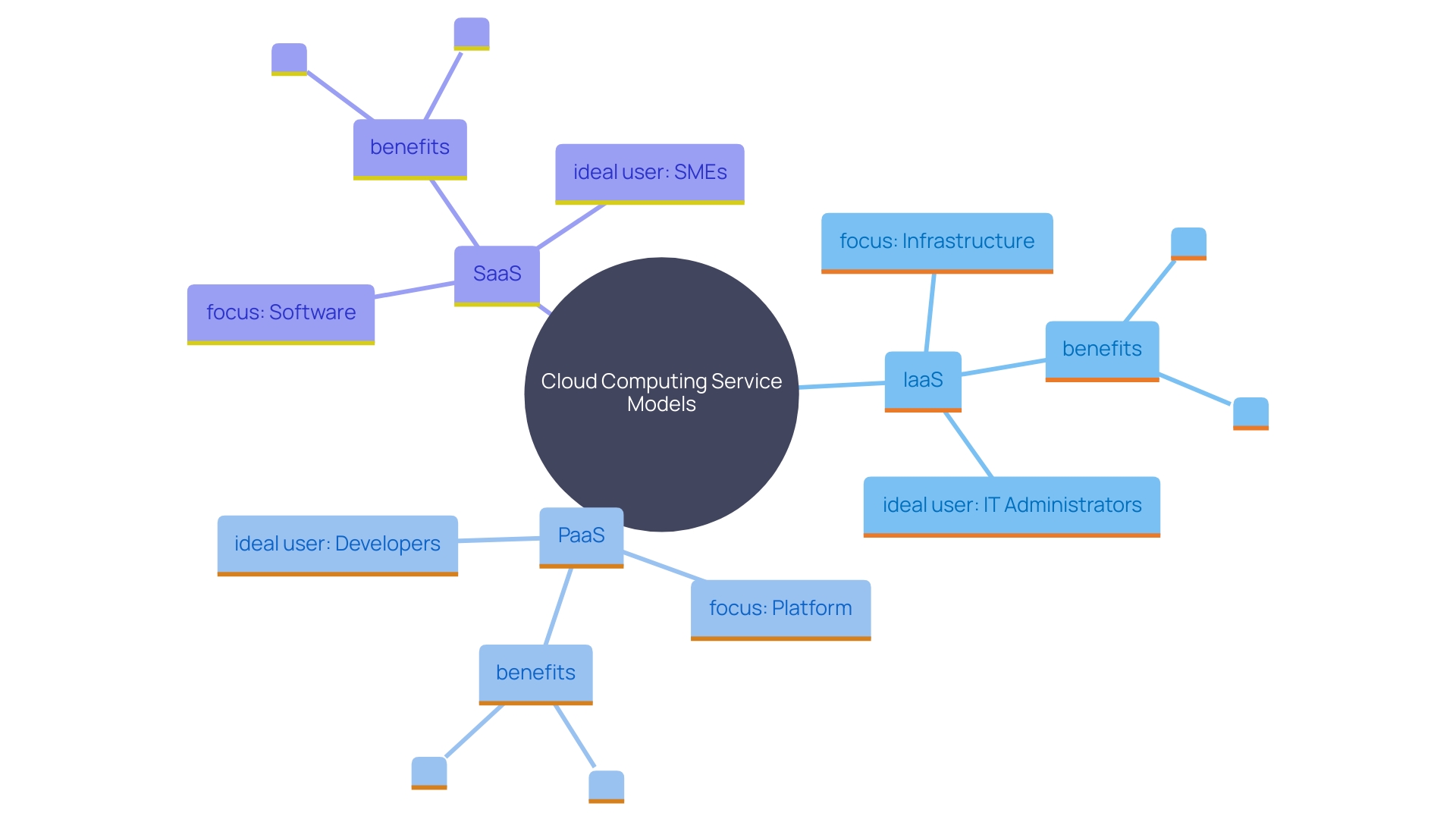Introduction
In an era where digital transformation is paramount, cloud computing has emerged as a revolutionary technology reshaping how data and applications are accessed and managed. By utilizing remote servers over the internet, it bypasses the need for traditional local servers or personal computers, offering enhanced flexibility, scalability, and efficiency. This article delves into the core aspects of cloud computing, exploring its three main service models—Infrastructure-as-a-Service (IaaS), Platform-as-a-Service (PaaS), and Software-as-a-Service (SaaS)—and their unique benefits.
Furthermore, it highlights real-world applications and market growth projections, providing a comprehensive understanding of why cloud computing is indispensable for modern enterprises.
What is Cloud Computing?
Cloud computing is a transformative technology enabling users to access and manage data and applications over the internet, bypassing the need for local servers or personal computers. Employing a network of distant servers, computing from the internet provides services like data storage, processing capabilities, and software applications. This model significantly enhances flexibility, scalability, and efficiency, allowing businesses and individuals to leverage state-of-the-art technology without the limitations of traditional infrastructure.
For example, Chess.com, a prominent platform with more than 150 million users, utilizes a hybrid IT infrastructure that incorporates public and on-site solutions. James Kelty, Head of Infrastructure, emphasizes that their focus on online technology has enabled them to reach a global audience, facilitating over ten million chess games daily.
Similarly, Delivery Hero, operating in over 70 countries, faced challenges with employees getting locked out of their accounts. By integrating cloud-based solutions like Okta and Google Workspace, they reduced account recovery time, enhancing overall productivity.
The cloud computing market, valued at $723.4 billion in 2023, is projected to grow at a CAGR of over 18% in the coming years. This growth is driven by factors such as the integration of IoT devices, increasing demand for AI, and the adoption of microservices architecture and DevOps models.
According to industry reports, the Software as a Service segment is anticipated to grow considerably, particularly among small and medium-sized enterprises, due to its cost-saving advantages and scalability. These developments emphasize the significance of online computing as a cornerstone of contemporary technological infrastructure.
The 3 Main Categories of Cloud Computing Services
Cloud computing is broadly categorized into three essential service types: Infrastructure-as-a-Service (IaaS), Platform-as-a-Service (PaaS), and Software-as-a-Service (SaaS). Each design addresses specific business needs and provides unique features, making a thorough understanding essential for optimal utilization of online technology.
Infrastructure-as-a-Service (IaaS): This framework offers virtualized computing resources over the internet. It is particularly beneficial for organizations seeking scalable and flexible infrastructure solutions without the hefty upfront investments in physical hardware. Companies can rent virtual machines, storage, and networks, paying only for what they use, thus optimizing resource allocation and cost management.
Platform-as-a-Service (PaaS): PaaS offers a development and deployment environment in the cloud, allowing developers to build applications without worrying about the underlying infrastructure. This model accelerates the development process by providing a suite of tools, libraries, and services, enabling faster time-to-market and reducing operational complexities.
Software-as-a-Service: This model provides software applications via the internet on a subscription basis, removing the requirement for organizations to install and manage software locally. Software-as-a-Service options are particularly popular among SMEs due to their cost-effectiveness and scalability. According to recent research, the software-as-a-service segment is anticipated to witness substantial growth, fueled by the rising adoption among SMEs seeking to evade large upfront licensing fees and high capital expenses. SaaS offerings reside in multi-tenant environments, providing benefits like lower costs, ease of use, and reduced installation time.
Grasping these service frameworks is essential for organizations looking to utilize online computing efficiently, as each framework provides unique benefits that can foster innovation, boost efficiency, and elevate overall business productivity.
Infrastructure-as-a-Service (IaaS)
Infrastructure as a Service (IaaS) delivers virtualized computing resources over the internet, allowing users to access essential infrastructure components such as servers, storage, and networking without the need for physical hardware. This framework is especially advantageous for businesses requiring flexible resources to manage fluctuating workloads and avoid the substantial upfront costs associated with purchasing hardware.
The global pandemic underscored the value of IaaS, as many companies had to quickly adapt to remote work environments. A common solution was to host virtual desktop infrastructure (VDI) on public networks, leveraging consistent VDI broker software like Citrix or VMware. This approach provided device-agnostic access, enabling employees to connect securely from various devices, including laptops and mobile phones.
Server revenue for edge data centers is projected to grow significantly, driven by the increasing adoption of telecom edge infrastructure. The implementation of AI at both the network core and edge highlights the evolving ecosystem, with AI data centers demanding massive bandwidth growth. This surge necessitates innovative solutions for cost efficiency and power management.
As Huffstetler notes, the rising demand for performance due to AI requires advanced cooling solutions. Traditional air conditioning can consume up to 40% of data center power, and water is often used for cooling, with companies like Google using billions of gallons annually. However, liquid cooling can reduce data center power consumption by up to 30% and significantly decrease water usage, offering a more sustainable alternative.

Platform-as-a-Service (PaaS)
Platform as a Service (PaaS) offers a comprehensive environment for developers to build, deploy, and manage applications efficiently, bypassing the complexities of infrastructure management. This model equips developers with essential tools and services that enhance the development lifecycle, ensuring applications are scalable and reliable. By leveraging PaaS, organizations can achieve faster deployment times, improved product quality, and a robust foundation for innovation. The $723.4 billion computing market, growing at over 18% CAGR, highlights the increasing shift towards PaaS solutions, driven by the adoption of AI, IoT, and microservices architectures. As cloud providers address past concerns around performance, security, and reliability, PaaS is becoming an integral part of the modern IT landscape, offering a transformative impact on software development and delivery.
Software-as-a-Service (SaaS)
Software delivered as a service offers centrally managed software applications accessible through the internet, removing the necessity for local installation or upkeep. This model allows users to access applications from anywhere, enhancing flexibility and convenience. Software as a Service is particularly beneficial for organizations aiming to reduce IT overheads and promote collaboration among users.
For instance, Sirius Technologies embraced cloud-based solutions to enhance its software development life cycle, lowering expenses and expanding its reach in the financial services sector. This approach has been instrumental in driving their transformation and ensuring accessible financial services. Furthermore, strategic partners such as Stefanini have shown how software as a service can enhance operational efficiency and encourage innovation, as evidenced by their digital workplace solutions for a significant multinational corporation.
Zoho's success story further emphasizes the benefits of software as a service. With over 750,000 paying customers, Zoho has balanced growth and profitability by focusing on customer value. Their software services have significantly contributed to their revenue growth and global expansion, especially in developing markets.
The increasing acceptance of software services among small and medium-sized enterprises is motivated by the desire to steer clear of substantial initial licensing expenses and elevated capital expenditures. Software as a Service delivers cost reductions via a multi-tenant setup and offers scalability, user-friendliness, and shorter installation duration. According to the World Economic Forum, the integration of advanced technologies like IoT, AI, and cloud computing is speeding up the adoption of software services, enabling businesses to operate more efficiently and adapt to changing market environments.
Comparison of IaaS, PaaS, and SaaS
Infrastructure as a Service (IaaS), Platform as a Service (PaaS), and Software as a Service (SaaS) each cater to distinct business needs and technological requirements. IaaS provides a high level of control over computing resources, making it ideal for companies that demand extensive customization and flexibility. This design is particularly beneficial for enterprises looking to rapidly scale their infrastructure while managing costs efficiently.
PaaS, on the other hand, focuses on streamlining the application development process. It provides a range of tools and resources that allow developers to create, launch, and oversee applications without the difficulties of handling the foundational hardware and software framework. This service approach is crucial for organizations aiming to accelerate their development cycles and bring products to market faster.
Lastly, software as a service is designed to deliver fully functional applications over the internet, eliminating the need for installation, maintenance, and management. This version is especially popular among small and medium enterprises (SMEs) due to its cost-saving benefits, as it avoids large upfront licensing fees and high capital costs. The SaaS market is experiencing substantial growth, driven by its scalability, ease of use, and the increasing demand from SMEs globally.
Each of these online support frameworks caters to particular organizational requirements, providing distinct benefits that correspond with diverse business objectives and operational plans.

Choosing the Right Cloud Computing Service Model
Choosing the suitable cloud model necessitates a thorough assessment of business needs, budget limitations, and technical knowledge. Organizations should begin by assessing their current IT infrastructure and identifying specific needs and operational goals.
When evaluating cloud-managed solutions, the initial step is to investigate and contrast various providers. Seek out those with a demonstrated history, robust security protocols, and a variety of offerings that match your organizational requirements. For example, experts like Amor Steinberg and Marinus Krommenhoek at BMW Group have successfully leveraged cloud solutions to modernize IT landscapes and maintain high security standards.
Cloud service models, like Software as a Service, have experienced significant demand, especially among small and medium-sized enterprises. SaaS offers cost savings by residing in a multi-tenant environment, which reduces licensing and hardware costs. It also provides scalability and minimizes installation time, making it an attractive option for growing businesses.
In terms of market growth, the cloud computing market size was valued at $723.4 billion in 2023 and is projected to grow at a CAGR of over 18% in the coming years. This growth is driven by factors like the integration of IoT devices, rising demand for AI, and the adoption of microservices and DevOps models.
By understanding these dynamics and selecting a provider that supports future scalability, organizations can make informed decisions that align with their long-term strategic goals. As Owen Powell, ICT Director at CNWL, emphasizes, having the right technology support is crucial for delivering essential services effectively.
Conclusion
The exploration of cloud computing reveals its pivotal role in modern technological frameworks, highlighting how it transforms data management and application access. By leveraging remote servers, businesses are able to enhance flexibility, scalability, and efficiency, thereby overcoming the limitations imposed by traditional infrastructures. The growth trajectory of the cloud computing market, projected to reach $723.4 billion by 2023, underscores its significance, driven by trends such as the integration of IoT, the rise of AI, and the adoption of microservices architectures.
The three main service models—Infrastructure-as-a-Service (IaaS), Platform-as-a-Service (PaaS), and Software-as-a-Service (SaaS)—each offer distinct advantages tailored to specific organizational needs. IaaS provides customizable infrastructure solutions, enabling businesses to scale efficiently without heavy investments in hardware. PaaS simplifies the application development process, allowing developers to focus on innovation rather than infrastructure management.
Meanwhile, SaaS delivers software applications via the internet, promoting cost savings and accessibility, particularly beneficial for small and medium enterprises.
Ultimately, the decision to adopt a cloud service model should be informed by a thorough assessment of business needs and operational goals. As organizations navigate this transformative landscape, selecting the right provider and service model will be crucial. By embracing cloud computing, enterprises can not only enhance their operational efficiencies but also position themselves strategically for future growth in an increasingly digital world.




